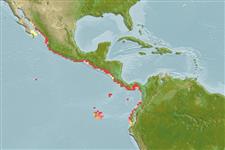Environment: milieu / climate zone / depth range / distribution range
Ökologie
seewasser; süßwasser; brackwasser; tiefenbereich 0 - 50 m (Ref. 189). Tropical; 28°N - 6°S, 111°W - 77°W (Ref. 189)
Eastern Pacific: central part of the Gulf of California (Rio Yaqui, Mexico) to the Gulf of Guayaquil, Peru.
Size / Gewicht / Alter
Maturity: Lm ? range ? - ? cm
Max length : 8.9 cm TL Männchen/unbestimmt; (Ref. 96339)
Rückenflossenstacheln (insgesamt) : 0; Afterflossenstacheln: 0; Afterflossenweichstrahlen: 19 - 23. Body moderately elongate, but somewhat compressed. Snout fairly short, about 3/4 eye diameter; maxilla long, tip sharply pointed, reaching almost to edge of gill cover; gill cover canals of walkeri-type. Anal fin moderate, its origin under or a little before midpoint of dorsal fin base. A narrow silver stripe along flank.
Pelagic (Ref. 96339). A schooling species occurring in coastal waters, most often in muddy estuaries in fully salt, brackish or apparently freshwater, penetrating only a few kilometers up rivers. Maturing females were caught in January, August and October in the Gulf of Nicoya, Costa Rica, suggesting a protracted spawning season. The eggs are oval. TL = 1.219 SL.
Life cycle and mating behavior
Geschlechtsreife | Fortpflanzung | Ablaichen | Eier | Fecundity | Larven
Spawn in school (Ref. 205).
Whitehead, P.J.P., G.J. Nelson and T. Wongratana, 1988. FAO Species Catalogue. Vol. 7. Clupeoid fishes of the world (Suborder Clupeoidei). An annotated and illustrated catalogue of the herrings, sardines, pilchards, sprats, shads, anchovies and wolf-herrings. FAO Fish. Synop. 125(7/2):305-579. Rome: FAO. (Ref. 189)
IUCN Rote Liste Status (Ref. 130435: Version 2024-1)
Can't connect to MySQL database (fbapp). Errorcode: Too many connections
